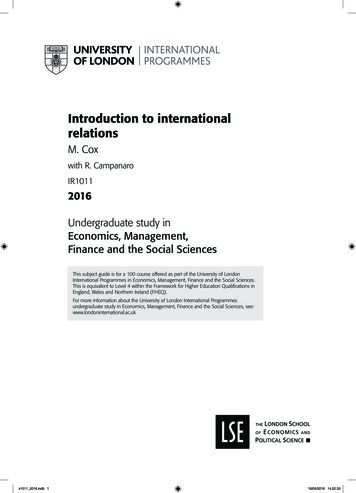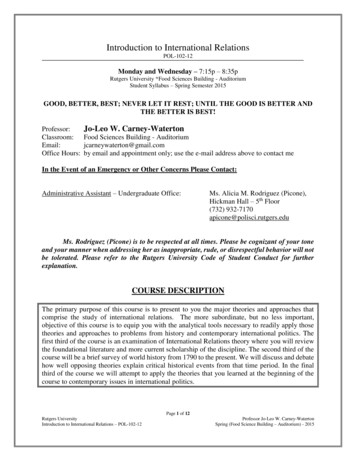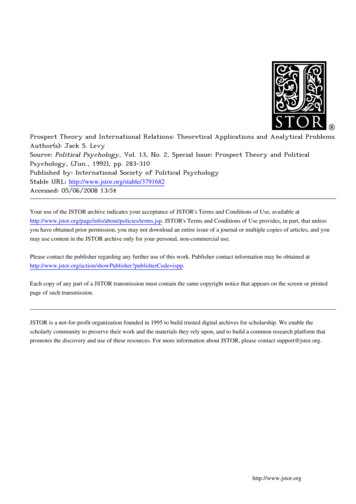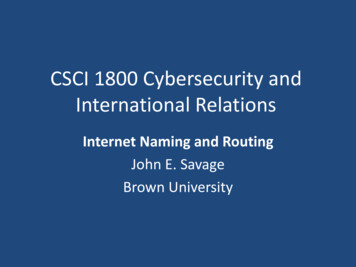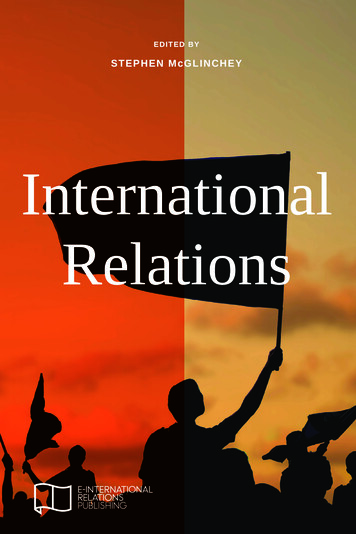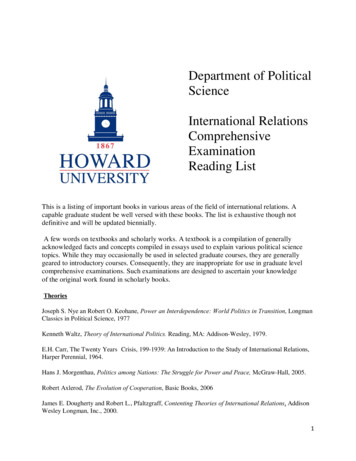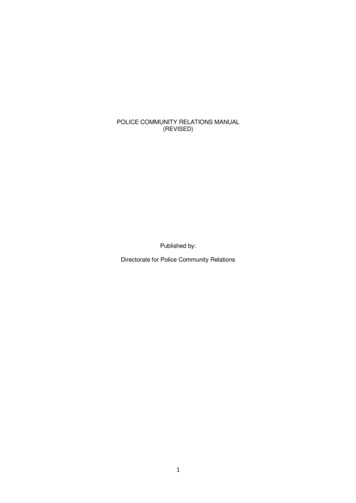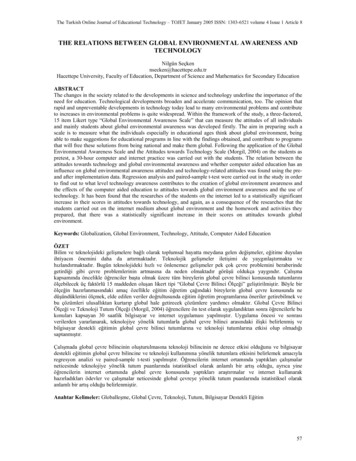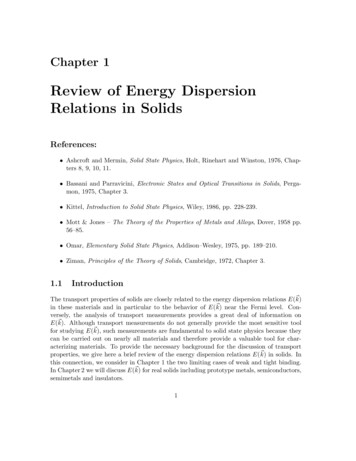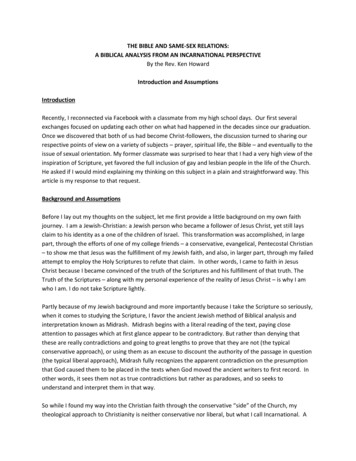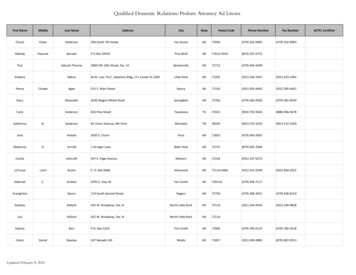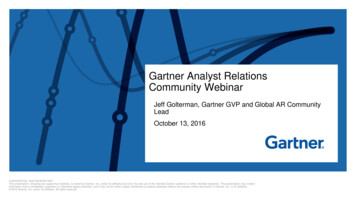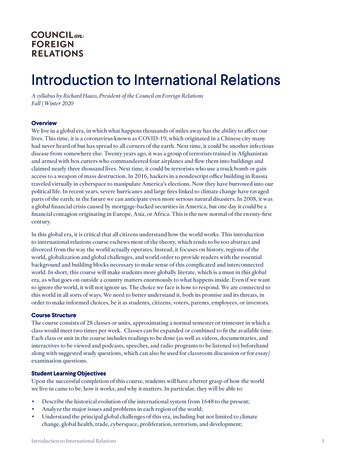
Transcription
Introduction to International RelationsA syllabus by Richard Haass, President of the Council on Foreign RelationsFall / Winter 2020OverviewWe live in a global era, in which what happens thousands of miles away has the ability to affect ourlives. This time, it is a coronavirus known as COVID-19, which originated in a Chinese city manyhad never heard of but has spread to all corners of the earth. Next time, it could be another infectiousdisease from somewhere else. Twenty years ago, it was a group of terrorists trained in Afghanistanand armed with box cutters who commandeered four airplanes and flew them into buildings andclaimed nearly three thousand lives. Next time, it could be terrorists who use a truck bomb or gainaccess to a weapon of mass destruction. In 2016, hackers in a nondescript office building in Russiatraveled virtually in cyberspace to manipulate America’s elections. Now they have burrowed into ourpolitical life. In recent years, severe hurricanes and large fires linked to climate change have ravagedparts of the earth; in the future we can anticipate even more serious natural disasters. In 2008, it wasa global financial crisis caused by mortgage-backed securities in America, but one day it could be afinancial contagion originating in Europe, Asia, or Africa. This is the new normal of the twenty-firstcentury.In this global era, it is critical that all citizens understand how the world works. This introductionto international relations course eschews most of the theory, which tends to be too abstract anddivorced from the way the world actually operates. Instead, it focuses on history, regions of theworld, globalization and global challenges, and world order to provide readers with the essentialbackground and building blocks necessary to make sense of this complicated and interconnectedworld. In short, this course will make students more globally literate, which is a must in this globalera, as what goes on outside a country matters enormously to what happens inside. Even if we wantto ignore the world, it will not ignore us. The choice we face is how to respond. We are connected tothis world in all sorts of ways. We need to better understand it, both its promise and its threats, inorder to make informed choices, be it as students, citizens, voters, parents, employees, or investors.Course StructureThe course consists of 28 classes or units, approximating a normal semester or trimester in which aclass would meet two times per week. Classes can be expanded or combined to fit the available time.Each class or unit in the course includes readings to be done (as well as videos, documentaries, andinteractives to be viewed and podcasts, speeches, and radio programs to be listened to) beforehandalong with suggested study questions, which can also be used for classroom discussion or for essay/examination questions.Student Learning ObjectivesUpon the successful completion of this course, students will have a better grasp of how the worldwe live in came to be, how it works, and why it matters. In particular, they will be able to: Describe the historical evolution of the international system from 1648 to the present;Analyze the major issues and problems in each region of the world;Understand the principal global challenges of this era, including but not limited to climatechange, global health, trade, cyberspace, proliferation, terrorism, and development;Introduction to International Relations1
Evaluate the role global governance can play in addressing the major problems in thecontemporary world;Discuss world order and describe factors that contribute to order and those that detract fromorder.Required BooksThis course is built around The World: A Brief Introduction (Penguin Press, 2020), with each of thebook’s chapters comprising one class and one chapter several classes. The book (hardcover) canbe purchased at stores or online from Amazon and other retailers. The list price is 28.00 but it isoften available for under 20.00. The kindle version costs 14.99. The course includes additionalrequired readings that supplement The World, but importantly students do not need to purchase anyadditional books. Instead, all of the additional readings are available online. Many of the articles aredrawn from Foreign Affairs, the magazine of record for international affairs. Students can purchasea subscription to Foreign Affairs that gives them unlimited access to the magazine’s entire catalog for 24.95. Other articles are drawn from news sources that for the most part are not behind a paywallor allow users to read a handful of articles each month for free before requiring them to purchase asubscription.Section 1: The Essential HistoryClass 1: From the Thirty Years’ War to the Outbreak of World War I (1618-1914) The World: A Brief Introduction, pages XV-13.In Our Time, “The Thirty Years War” (BBC podcast).Brendan Simms, “Castlereagh’s Catechism: A Statesman’s Guide to Building a New Concert ofEurope,” Foreign Affairs (March/April 2013).Julian Gewirtz, “‘Imperial Twilight’ Review: An Explosive Mix of Trade and Politics,”The Wall Street Journal, May 17, 2018.In Our Time, “The Opium Wars,” (BBC podcast).Discussion Questions:1.2.3.4.Why and how did countries emerge from the devastation of the Thirty Years’ War?What was the Concert of Europe and how did it help to preserve order in Europe?Why does China refer to the period between 1939 and 1949 as the “century of humiliation”?How do you think it shapes how China views the world?Why did World War I break out? Could it have been avoided?Class 2: From World War I Through World War II (1914-1945) The World: A Brief Introduction, pages 14-28.Thomas Laqueur, “Some Damn Foolish Thing” (book review of The Sleepwalkers),London Review of Books, December 2013.The Ever Widening War, “The War of Empires” (BBC radio program).The Ever Widening War, “The Atlantic War” (BBC radio program).President Woodrow Wilson, “Fourteen Points Speech,” January 8, 1918.HistoryExtra, “Appeasement and the road to World War Two” (podcast).Discussion Questions:1.2.3.4.What is isolationism? In what periods of history was American foreign policy defined byisolationism?Why did the United States finally enter World War I?Was the Treaty of Versailles too punitive? Did it lead to World War II?What was the League of Nations and what did its backers believe it could accomplish?Introduction to International Relations2
5.6.What is appeasement, and did it help pave the way for World War II?Was World War II inevitable? If so, what caused it? If not, what could have been done?Class 3: The Cold War (1945-1989) The World: A Brief Introduction, pages 29-42.CNN, Cold War – Iron Curtain (documentary).Winston Churchill, “The Sinews of Peace” (Iron Curtain Speech), March 5, 1946.United Nations Charter, June 1945.CNN, Cold War – Marshall Plan (documentary).President Harry S. Truman, “Address Before a Joint Session of Congress”(Truman Doctrine Speech), March 12, 1947.“X” (George Kennan), “The Sources of Soviet Conduct,” Foreign Affairs (July 1947).Discussion Questions:1.2.3.4.5.What factors contributed to the development of the Cold War? Was it inevitable?What were the Truman Doctrine and the Marshall Plan?Why were NATO and the Warsaw Pact created? Were they successful?Define “containment.” What were the assumptions of that strategy, and what were thealternatives? Was it a successful strategy?Why did the Cold War stay “cold”? Why did the competition between the United States andthe Soviet Union remain bounded?Class 4: The Post-Cold War Era (1989-Present) The World: A Brief Introduction, pages 43-57.Francis Fukuyama, “The End of History?” The National Interest (Summer 1989).President George H. W. Bush, “Address Before a Joint Session of Congress”(New World Order Speech), September 11, 1990.Samuel P. Huntington, “The Clash of Civilizations?” Foreign Affairs (Summer 1993).Charles Krauthammer, “The Unipolar Moment,” Foreign Affairs (1990).Anthony Lake, “From Containment to Enlargement,” Remarks at Johns Hopkins School ofAdvanced International Studies, September 21, 1993.Discussion Questions:1.2.3.4.Why did some scholars argue that the end of the Cold War marked the “end of history”?Do you agree with this thesis?Why was Iraq’s invasion of Kuwait a challenge to order? Should the United States have usedforce to turn back Iraqi aggression?What should the United States have done with its “unipolar moment” following the Cold War?How would you grade the United States on its performance?Some argue that the United States and China are destined to become locked in a new coldwar. Do you agree? If the United States and China do end up in a new cold war, what mightbe the consequences for both countries and for the world?Section 2: Regions of the WorldClass 5: Europe The World: A Brief Introduction, pages 61-81.Council on Foreign Relations, “How Does the European Union Work?” (Backgrounder).Susan Glasser, “Putin the Great: Russia’s Imperial Impostor,” Foreign Affairs (Sep/Oct 2019).Introduction to International Relations3
Anne Applebaum, “The False Romance of Russia,” TheAtlantic.com, December 12, 2019.Matthias Matthijs, “The Right Way to Fix the EU,” Foreign Affairs (May/June 2020).Lawrence Freedman, “Britain Adrift,” Foreign Affairs (May/June 2020).Discussion Questions:1.2.3.4.5.How did Europe evolve from a place with so much strife (World Wars I and II) to a regionlargely at peace?What is the European Union (EU) and what was the impetus behind it? What is meant bythe debate between building a “United Europe of States” or a “United States of Europe”?What is “Brexit” and how will it affect the future of the European project?What accounts for the increased friction between the United States and Russia?Was it inevitable?What is the most serious challenge facing Europe?How likely is the continent to meet the challenge?Class 6: East Asia and the Pacific The World: A Brief Introduction, pages 82-96.The President’s Inbox, “Fredrik Logevall on Lessons of the Vietnam War” (podcast).The World Bank, Live Long and Prosper: Aging in East Asia and Pacific, pp. 1-18.Elizabeth Economy, “China’s New Revolution,” Foreign Affairs (May/June 2018).The Economist, “A Sea of Disputes,” February 21, 2011.Nadège Rolland, “A Concise Guide to the Belt and Road Initiative,” National Bureau of AsianResearch, April 11, 2019.Richard Bush and Shelley Rigger, “The Taiwan Issue and the Normalization of US-ChinaRelations,” The Carter Center, January 16, 2019.The President’s Inbox, “What Should U.S. Policy Toward China Be?” (podcast).Discussion Questions:1.2.3.4.5.What accounts for Asia’s remarkable success in the 75 years following World War II?What is the “Asian economic miracle” and what caused this economic boom?Why did the United States fight the Korean War? Was the same rationale used to justify theVietnam War? Were the assumptions and the wars justified?What are the American and Chinese positions regarding the status of Taiwan?What are the origins of their disagreement regarding the island’s status?Does a nuclear North Korea represent a threat to the United States?What should the United States do (if anything) to address it?Class 7: South Asia The World: A Brief Introduction, pages 97-110.Ashley J. Tellis, “Are India-Pakistan Peace Talks Worth a Damn?” Carnegie Endowment forInternational Peace, September 2017, pages 1-23.Sumit Ganguly, “Modi Crosses the Rubicon in Kashmir,” Foreign Affairs, August 8, 2019.Ashutosh Varshney, “Modi Consolidates Power: Electoral Vibrancy, Mounting Liberal Deficits,”Journal of Democracy October 2019.Husain Haqqani, “How Will Military Generals Solve Economic Issues?” ThePrint.in, January20, 2020.Carter Malkasian, “How the Good War Went Bad,” Foreign Affairs (March/April 2020).Gwen Robinson, “The Rise and Rise of Bangladesh,” Nikkei Asia Review, December 19, 2018.Introduction to International Relations4
Discussion Questions:1.2.3.4.How would you describe the relationship between India and Pakistan?What is the conflict over Kashmir?Why did the United States fight a war in Afghanistan, and who was it fighting?Was the war successful? Why or why not?How would you assess future prospects for India and Pakistan? Are they trending in theright or wrong direction?Class 8: The Middle East The World: A Brief Introduction, pages 111-130.Council on Foreign Relations, “What Is U.S. Policy on the Israeli-Palestinian Conflict?”(Backgrounder).President Jimmy Carter, “State of the Union address” (Carter Doctrine), January 23, 1980.UN Development Programme, “Arab Human Development Report 2016,” pages 21-42.Larry Diamond, “What Went Wrong in Iraq,” Foreign Affairs (Sep/Oct 2004).Richard Haass, “The New Middle East,” Foreign Affairs (November/December 2006).President Barack Obama, “A New Beginning” (Cairo Speech), June 4, 2009.Steven Cook, “The Middle Eastern Revolutions That Never Were,” The American Interest(2015).Marc Lynch, “The New Arab Order: Power and Violence in Today’s Middle East,” ForeignAffairs (September/October 2018).Secretary of State Michael Pompeo, “A Force for Good: America Reinvigorated in the MiddleEast,” January 10, 2019.Hal Brands, Steven Cook, and Kenneth Pollack, “RIP the Carter Doctrine, 1980-2019,” ForeignPolicy (Spring 2020).Discussion Questions:1.2.3.4.5.6.7.What do you think accounts for the Middle East’s long history of strife?To what extent does Iran represent a threat to the region?Why are most countries of the Middle East lagging so many global measures of democracyand development?What was the “Arab Spring”? What triggered it, and what was the outcome?What was the Carter Doctrine and do you think it is still relevant today?Why did the United States invade Iraq in 2003? Was it a preemptive or preventive war?Was the war justified?Do you believe there will be a lasting peace between Israel and the Palestinians?If so, what do you think such a peace would look like? If not, what will be the outcome?Class 9: Africa The World: A Brief Introduction, pages 131-142.Council on Foreign Relations, “Africa’s Leaders for Life” (Backgrounder).United Nations Development Programme, “Africa Human Development Report 2016,” pages12-33.The World Bank, “Poverty in a Rising Africa,” pages 3-23.The Economist, “The march of democracy slows: Threats to democratic rule in Africa aregrowing, but time and demography are against the autocrats,” August 20, 2016.The Economist, “Africa is attracting ever more interest from powers elsewhere,” March 7, 2019.John Campbell and Jack McCaslin, “Zuma’s Exit Was Proof of the Health of South Africa’sDemocracy,” World Politics Review, March 23, 2018.Sarah Chayes, “Thunder God: Values, Corruption, and Nigeria’s Election,” World Politics Review, April 28, 2015.Introduction to International Relations5
Discussion Questions:1.2.3.4.5.Observers often term Nigeria and South Africa the continent’s “two anchors.”Why are these two countries so important?Why are outside powers increasingly interested in building influence in Africa?Do you believe the continent’s economic growth will outpace the growth of its population,leading to further economic development, or will demographic pressures swallow up anygrowth?Is democracy gaining ground in Africa, or is it receding to autocracy?What is the role of the African Union?Class 10: The Americas The World: A Brief Introduction, pages 143-153.McKinsey Global Institute, “Where Will Latin America’s Growth Come From?” (April 2017).International Crisis Group, “Mafia of the Poor: Gang Violence and Extortion in CentralAmerica” (2017), pages 1-18.Ben Raderstorf, Michael Camilleri, Carole J. Wilson and Elizabeth J. Zechmeister, “Beneath theViolence: How Insecurity Shapes Daily Life and Emigration in Central America” (2017).Denise Dresser, “Can Mexico Be Saved?” Foreign Affairs (Sep/Oct 2018).Thomas Lovejoy, “The Amazon Is Nearing the Point of No Return,” Foreign Affairs, February10, 2020.Moisés Naím and Francisco Toro, “Venezuela’s Suicide: Lessons From a Failed State,” ForeignAffairs (Nov/Dec 2018).Jonathan Blitzer, “How Climate Change is Fuelling the U.S. Border Crisis,” The New Yorker,April 3, 2019.Carla Hills, “NAFTA’s Economic Upsides,” Foreign Affairs (Jan/Feb 2014).Jorge Castaneda, “NAFTA’s Mixed Record,” Foreign Affairs (Jan/Feb 2014).Discussion Questions:1.2.3.4.5.6.7.What is the Monroe Doctrine and Roosevelt Corollary? Are they still in force?What was the Cuban Missile Crisis? How was it resolved?Which countries compose the “Northern Triangle” and what is causing widespread violencein these countries? How is that affecting migration patterns?Why is the Amazon so important to global efforts to combat climate change?What can be done to protect the Amazon?How did Venezuela fall from Latin America’s richest country to one where starvationis the norm?What, if any, contribution is made by the Organization of American States (OAS)?How has NAFTA reshaped the region?Section 3: The Global EraClass 11: Globalization The World: A Brief Introduction, pages 157-165.Peterson Institute for International Economics, “What is Globalization? And How Has theGlobal Economy Shaped the United States?” (interactive).Henry Farrell and Abraham Newman, “Chained to Globalization: Why It’s Too Late toDecouple,” Foreign Affairs (Jan/Feb 2020).Henry Farrell and Abraham Newman, “Will the Coronavirus End Globalization as We Know It?The Pandemic Is Exposing Market Vulnerabilities No One Knew Existed,” Foreign Affairs (March 16, 2020).Introduction to International Relations6
Shannon O’Neil, “How to Pandemic-Proof Globalization: Redundancy, Not Reshoring, Is theKey to Supply Chain Security,” Foreign Affairs (April 1, 2020).Robert D. Kaplan, “Coronavirus Ushers in the Globalization We Were Afraid Of,” BloombergOpinion, March 20, 2020.Discussion Questions:1.2.3.4.What is globalization?What led to globalization?What do you believe are the best and worst aspects of globalization?Whom has it helped and whom has it hurt? Try to provide examples from your own life.To what extent can governments, international institutions, and individuals respond to,control, or limit the effects of globalization?Class 12: Terrorism and Counterterrorism The World: A Brief Introduction, pages 166-172.J.M. Berger, “The Difference between a Killer and a Terrorist,” The Atlantic, April 26, 2018.William F. Shugart III, “An Analytical History of Terrorism,” Public Choice, vol. 128 (2006),pages 7-39.Graeme Wood, “What ISIS Really Wants,” The Atlantic (March 2015).Center on Extremism, New Hate and Old: The Changing Face of American White Supremacy(New York: Anti-Defamation League of B’nai B’rith).The White House, National Strategy for Counterterrorism of the United States of America(October 2018).Robert Malley and Jon Finer, “The Long Shadow of 9/11: How Counterterrorism Warps U.S.Foreign Policy,” Foreign Affairs (July/August 2018).The President’s Inbox, “The Changing Landscape of Domestic Terrorism, With BruceHoffman” (podcast).Discussion Questions:1.2.3.4.What distinguishes terrorism from other forms of violence?Why is it hard to prevent terrorism? What can be done to address this challenge?Are there examples of terrorists who have succeeded in achieving their objectives?What is the scale of the challenge terrorism presents to the United States?How much of a priority should the United States place on combating terrorism?Class 13: Nuclear Proliferation The World: A Brief Introduction, pages 173-182.Treaty on the Non-Proliferation of Nuclear Weapons (NPT)John Mueller, “Nuclear Weapons Don’t Matter: But Nuclear Hysteria Does,” Foreign Affairs(Nov/Dec 2018).Nina Tannenwald, “The Vanishing Nuclear Taboo? How Disarmament Fell Apart,” ForeignAffairs (Nov/Dec 2018).Elbridge Colby, “If You Want Peace, Prepare for Nuclear War A Strategy for the New GreatPower Rivalry,” Foreign Affairs (Nov/Dec 2018).Discussion Questions:1.2.3.Why do countries pursue nuclear weapons?Countries can pursue “vertical proliferation” or “horizontal proliferation.” How do thesediffer?What is the NPT and what are the agreement’s main pillars? Has it been successful atachieving its objectives?Introduction to International Relations7
4.5.6.Is a world with more nuclear powers more dangerous? Why or why not?What policy tools can be used to thwart a country’s effort to develop nuclear weapons?Which countries have nuclear weapons and which countries may be trying to build nuclearweapons? Do you think other countries will eventually try to develop nuclear weapons oftheir own? What would be the consequences?Class 14: Climate Change The World: A Brief Introduction, pages 183-192.Elizabeth Kolbert, “The Siege of Miami,” The New Yorker, December 14, 2015.David Wallace-Wells, “The Uninhabitable Earth,” New York Magazine, July 10, 2017.Nathaniel Rich, “Losing Earth: The Decade We Almost Stopped Climate Change,”The New York Times Magazine, August 1, 2018.Sarah Gibbens, “The Amazon is burning at record rates—and deforestation is to blame,”National Geographic, August 21, 2019.Council on Foreign Relations, “InfoGuide: Deforestation in the Amazon.”The President’s Inbox, “The Coming Climate Disruption, With Alice C. Hill” (podcast).William Nordhaus, “The Climate Club: How to Fix a Failing Global Effort,” Foreign Affairs(May/June 2020).Discussion Questions:1.2.3.4.What is climate change and how does it differ from pollution and the weather?What causes climate change, and what evidence is there for it? Have you seen the effects ofclimate change in your daily life?What can be done to address climate change (go into mitigation, adaptation, andgeoengineering)? How can you alter your behavior to combat climate change?What are the Paris Accords? Do you think countries will meet their obligations under theagreement? Is the agreement ambitious enough? If not, what else might be tried?Class 15: Migration The World: A Brief Introduction, pages 193-200.Council on Foreign Relations, “No Refuge” (InfoGuide).United Nations International Organization for Migration, World Migration Report 2020, pages19-51.Eduardo Porter and Karl Russell. “Migrants are on the Rise Around the World, and MythsAbout Them are Shaping Attitudes,” The New York Times, June 20, 2018.Bipartisan Policy Center, Policy Proposals to Address the Central American Migration Challenge,July 26, 2019.Azem Ahmed, Miriam Jordan and Kirk Semple, “A Closed Border, Dashed Hopes and aLooming Disaster,” The New York Times, March 21, 2020.The President’s Inbox, “What Would a Smart Immigration Policy Look Like?” (podcast).Discussion Questions:1.2.3.4.5.How big of a challenge is migration? What are its causes and consequences?What are the differences among an economic migrant, an internally displaced person, and arefugee? In what ways are the distinctions blurry?Which countries are migrants attracted to? Which countries do they primarily come from?What are the positive and negative effects of immigration on the country that migrantssettle in?In which ways are global arrangements regarding migrants insufficient?What should be done to address this gap?Introduction to International Relations8
Class 16: The Internet, Cyberspace, and Cybersecurity The World: A Brief Introduction, pages 201-207.Council on Foreign Relations, “Cyber Operations Tracker” (interactive).Josh Gold, “Toward Norms in Cyberspace: Recent Progress and Challenges,” CanadianInternational Council, January 7, 2019.David E. Sanger, “Obama Order Sped Up Wave of Cyberattacks Against Iran,” The New YorkTimes, June 1, 2012.Adam Segal, “When China Rules the Web,” Foreign Affairs (Sep/Oct 2018).Helen Dixon, “Regulate to Liberate: Can Europe Save the Internet?” Foreign Affairs (Sep/Oct2018).Laurens Cerulus and Mark Scott, “Europe seeks to lead a new world order on data,” POLITICO,June 7, 2019.Alan Beattie, “Technology: How the US, EU and China compete to set industry standards,”Financial Times, July 24, 2019.The Economist, “America does not want China to dominate 5G mobile networks,” April 8,2020.Discussion Questions:1.2.3.4.How do the United States, Europe, and China differ on rules for regulating cyberspace?How would you go about improving global governance in cyberspace?What standards or norms do you believe need to be upheld in cyberspace?Why is it so difficult to deter cyber attacks?Class 17: Global Health The World: A Brief Introduction, pages 208-214.Council on Foreign Relations, “What Does the World Health Organization Do?”(backgrounder).The President’s Inbox, “Epidemics in World History, With Frank M. Snowden” (podcast).Jin Wu, Weiyi Cai, Derek Watkins, and James Glanz, “How the Virus Got Out” New York Times,March, 22, 2020.Jeremy Page, Wenxin Fan, and Natasha Khan, “How It All Started: China’s Early CoronavirusMissteps,” The Wall Street Journal, March 6, 2020.David Fidler, “The World Health Organization and Pandemic Politics,” Think Global Health,April 10, 2020.Stephen Buranyi, “The WHO v Coronavirus: Why It Can’t Handle the Pandemic,”The Guardian, April 10, 2020.Francis Fukuyama, “The Pandemic and Political Order: It Takes a State,” Foreign Affairs (July/August 2020).Bill Gates, “How the pandemic will shape the near future” (TED Talk).Discussion Questions:1.2.3.4.5.What is a noncommunicable disease and how does it differ from a communicable disease?Why are noncommunicable diseases a bigger problem now than they have been in the past?How should this issue factor into the global health agenda?How did COVID-19 morph from a local outbreak into a global pandemic? What can bedone to halt the spread of the disease? What does it tell you about global health governance?What is the World Health Organization’s mission and how would you rate its effectiveness?What are the International Health Regulations (IHR), and have countries met theirobligations under the IHR?What more might be done to improve global health?Introduction to International Relations9
Class 18: Trade and Investment The World: A Brief Introduction, pages 215-229.Soumaya Keynes and Chad P. Brown, “Trade Talks: Happy 70th GATTiversary – The Origins ofMultilateral Trade” (podcast).Council on Foreign Relations, “What’s Next for the WTO?” (backgrounder).OECD, “Trade Policy Implications of Global Value Chains,” May 2013.OECD, “Making Trade Work for All,” May 2017.White House Council of Economic Advisers, “The Economic Benefits of U.S. Trade,”May 2015.Chad Brown and Douglas Irwin, “Trump’s Assault on the Global Trading System,”Foreign Affairs (Sep/Oct 2019).Edward Alden, “The Global Trading System: What Went Wrong and How to Fix It,”Japan Spotlight (May/June 2019).The President’s Inbox, “Should the United States Rethink Its Trade Policy?” (podcast).Discussion Questions:1.2.3.4.5.6.Why do countries trade with one another? What is the concept of comparative advantage?What are the advantages and disadvantages of international trade?What are the types of barriers countries erect to manage trade?Do you believe international trade is a net positive?In what ways has the global trading system fallen short and what can be done to strengthen it?What can be done to help individual workers whose jobs disappear?Class 19: Currency and Monetary Policy The World: A Brief Introduction, pages 230-239.Council on Foreign Relations, “What Is the U.S. Federal Reserve?” (backgrounder).Council on Foreign Relations, “The IMF: The World’s Controversial Financial Firefighter”(backgrounder).C. Fred Bergsten, “The Dollar and the Deficits: How Washington Can Prevent the Next Crisis,”Foreign Affairs (Nov/Dec 2009).Barry Eichengreen, “The Renminbi Goes Global: The Meaning of China’s Money,”Foreign Affairs (Mar/Apr 2017).Kathleen McNamara, “The Euro in Decline? How the Currency Could Spoil the GlobalFinancial System,” Foreign Affairs, January 12, 2018.Henry M. Paulson Jr. “The Future of the Dollar: U.S. Financial Power Depends on Washington,Not Beijing,” Foreign Affairs, May 19, 2020.Discussion Questions:1.2.3.4.5.What is monetary policy?What are the advantages and disadvantages of having a relatively strong currency and arelatively weak currency?How can a central bank influence – or manipulate – its country’s exchange rate?What is the International Monetary Fund’s (IMF) mission? Has it been successful inachieving its stated goals?Do you think the dollar will remain the world’s de facto reserve currency for the foreseeablefuture? Why or why not? What is the likeliest challenger?Class 20: Development The World: A Brief Introduction, pages 240-250.United Nations, The Sustainable Development Report 2019.Introduction to International Relations10
Council on Foreign Relations, “The World Bank Group’s Role in Global Development”(backgrounder).Jagdish Bhagwati, “Banned Aid: Why International Assistance Does Not Alleviate Poverty”(review of Dead Aid), Foreign Affairs (Jan/Feb 2010).William Easterly, “The Roots of Hardship” (review of Why Nations Fail), The Wall Street Journal,March 24, 2012.William Easterly, “Annual Hayek Lecture 2015” (video).Abhijit Banerjee and Esther Duflo, “How Poverty Ends: The Many Paths to Progress – and WhyThey Might Not Continue,” Foreign Affairs (Jan/Feb 2020).Jeffrey Sachs, “Trials and Tribulations: A Response to ‘How Poverty Ends,’” Foreign Affairs(May/June 2020).Discussion Questions:1.2.3.4.In which areas has global development advanced the most over the last half century?In which areas does it still lag?Why do some countries succeed in developing their economies while others fall behind?Does international aid help poorer countries develop? What other tools might help?What is the World Bank’s mission, and how successful has the organization been in carryingout that mission?Section 4: Order and DisorderClass 21: Sovereignty The World: A Brief Introduction, pages 253-261.In Our Time, “Sovereignty,” (BBC podcast).Kofi Annan, “Two Concepts of Sovereignty,” The Economist, September 16, 1999.International Developm
order. Required Books This course is built around The World: A Brief Introduction (Penguin Press, 2020), with each of the . (
